Abstract
The effects of metals on subcellular organelle functions have been reviewed in relation to carcinogenesis. Perturbations of the normal uptake and metabolism of carcinogens can arise through changes in microsomal enzyme activities, membrane permeabilities, and cell turnover. Metal effects on heme-dependent oxidative functions are well documented and are primarily manifested by increased heme degradation rates (microsomal heme oxygenase activity), decreased heme production (mitochondrial and cytosolic heme biosynthetic enzymes) and, in the case of a few metals, through nuclear effects of metals on the induction of microsomal enzymes. Many metals are accumulated by lysosomes, but known effects of metals on the function of these organelles in sequestering and storing organic compounds are few. Studies of changes in plasma or mitochondrial membrane permeabilities by metals have centered mainly on the susceptibility of membrane ATPase activities to metal ion alteration and on the involvement of metals in lipid peroxidation and free radical formation. Knowledge of the effects of metals on subcellular organelle functions should aid in the understanding of the mechanisms by which metal ions may play a role in the carcinogenic response.
Full text
PDF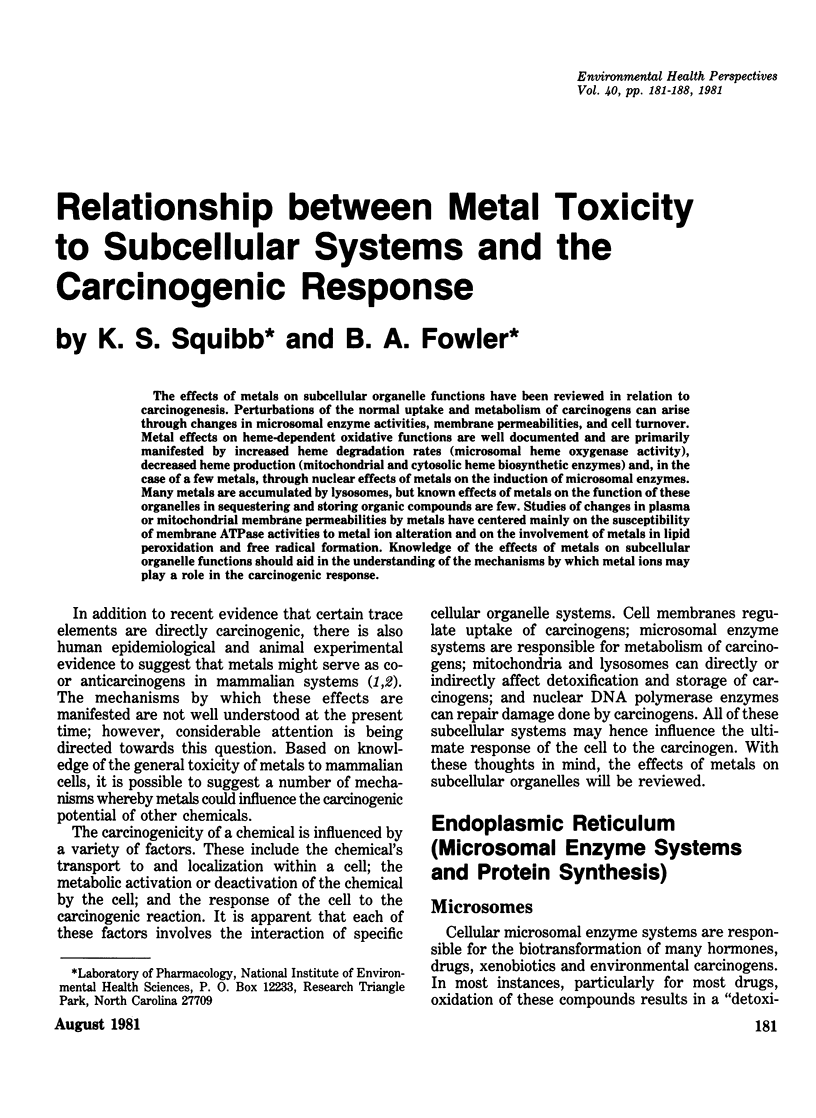
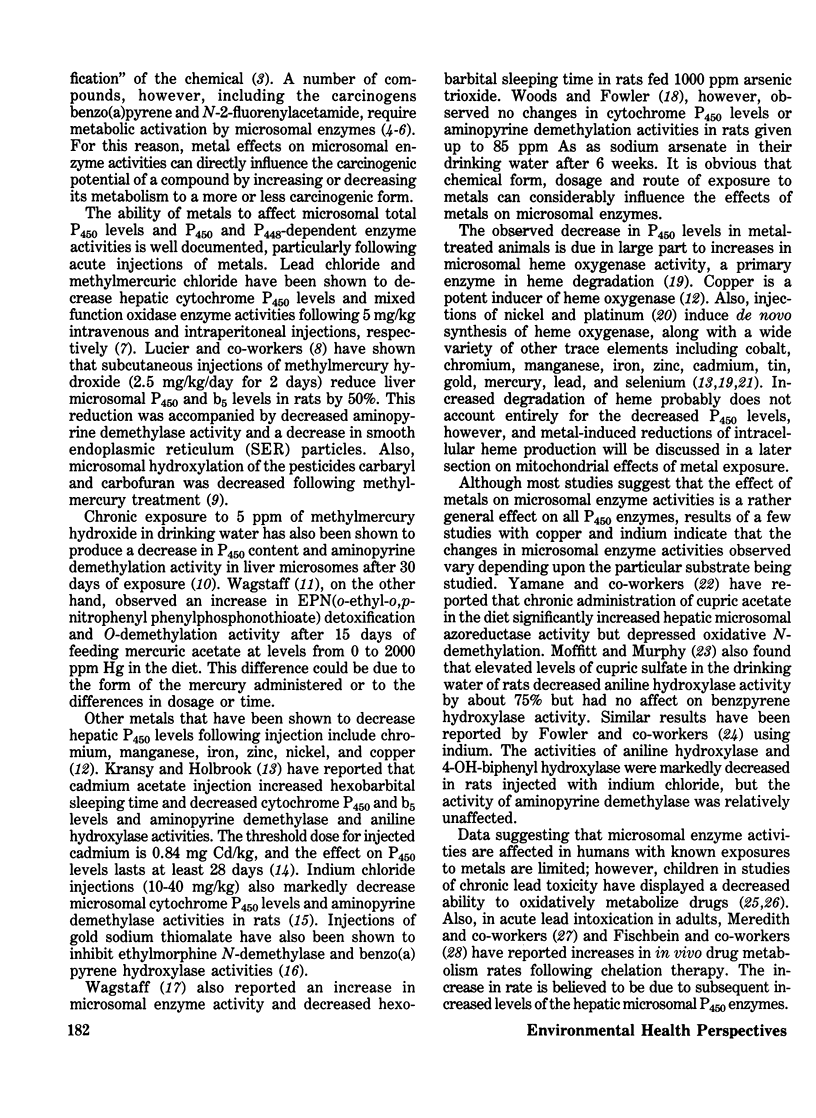
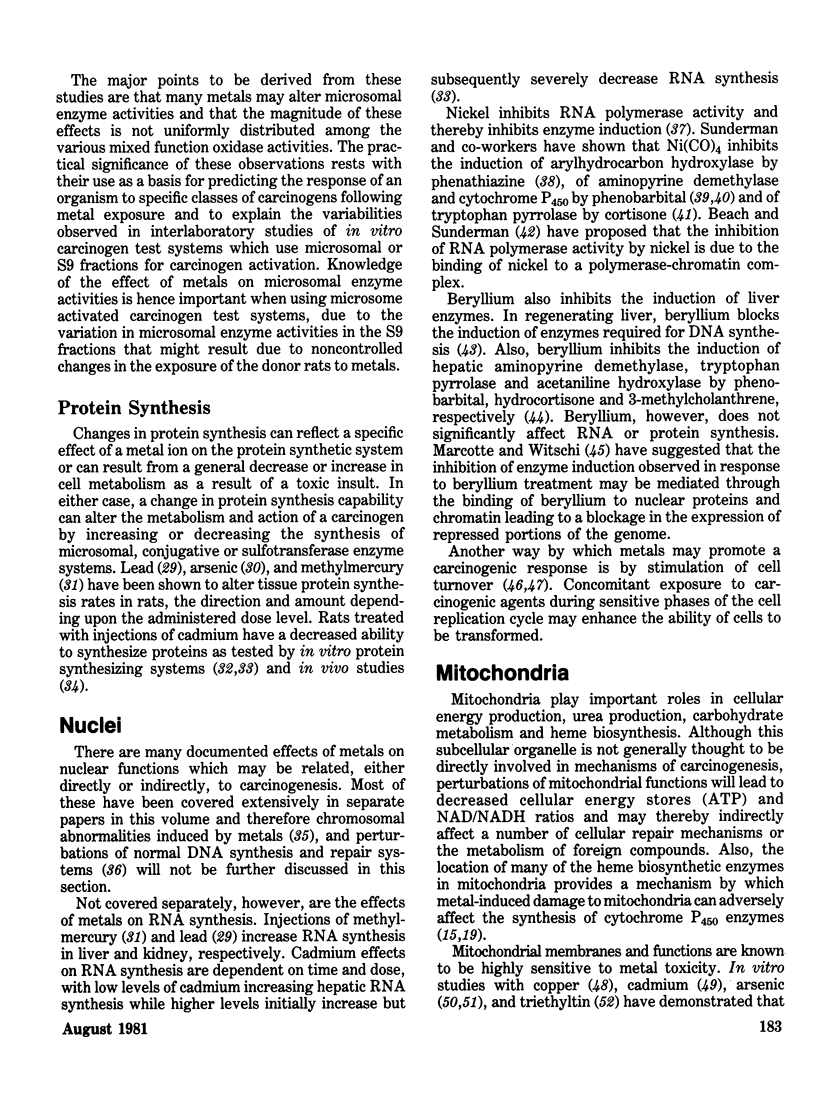
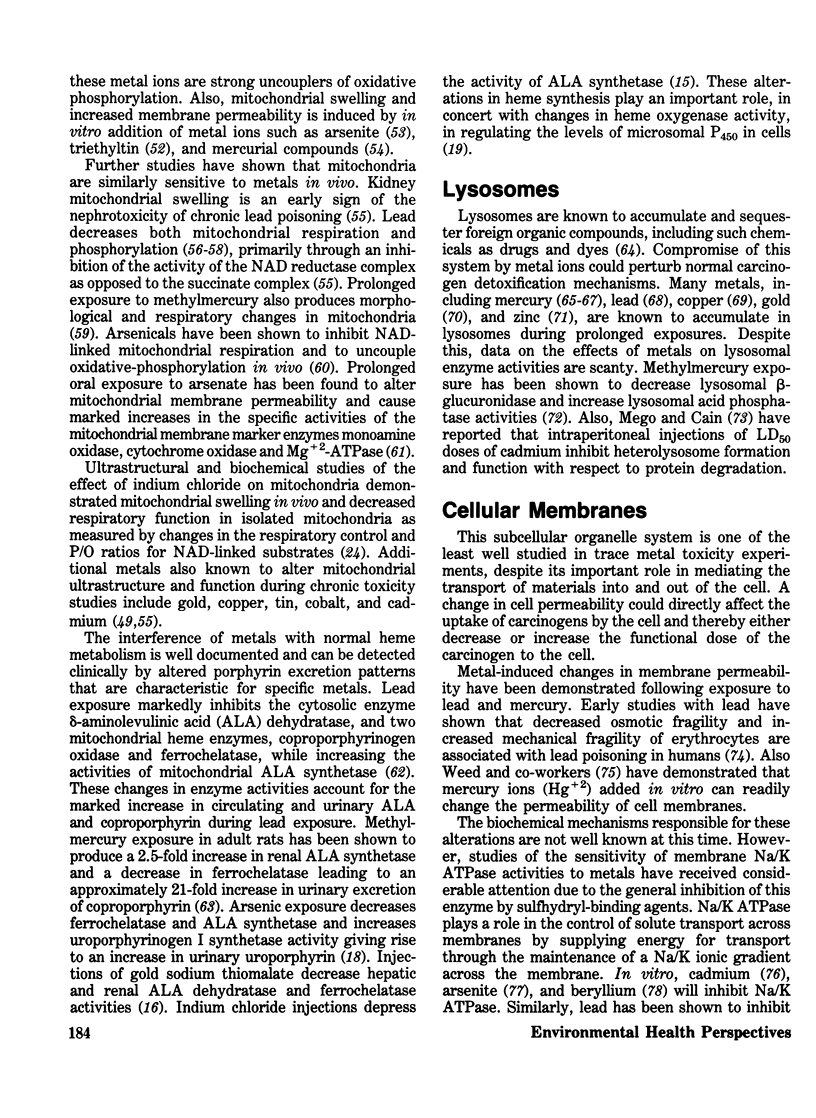

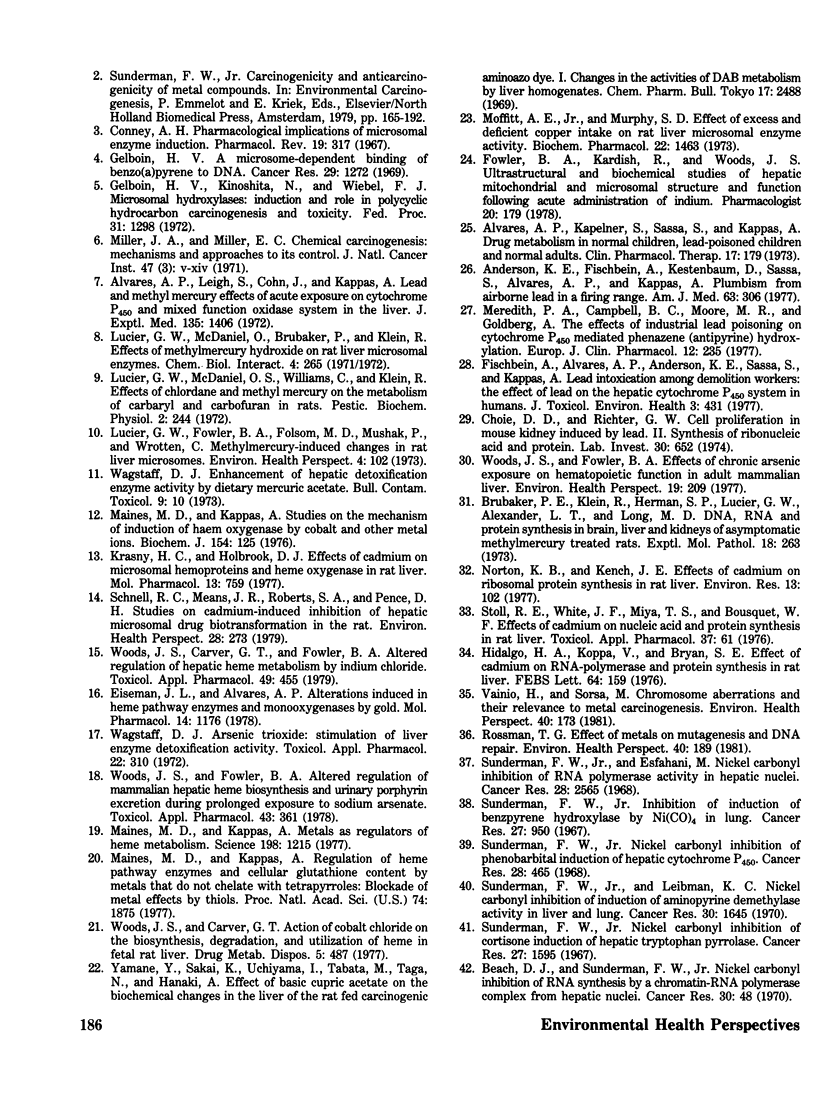
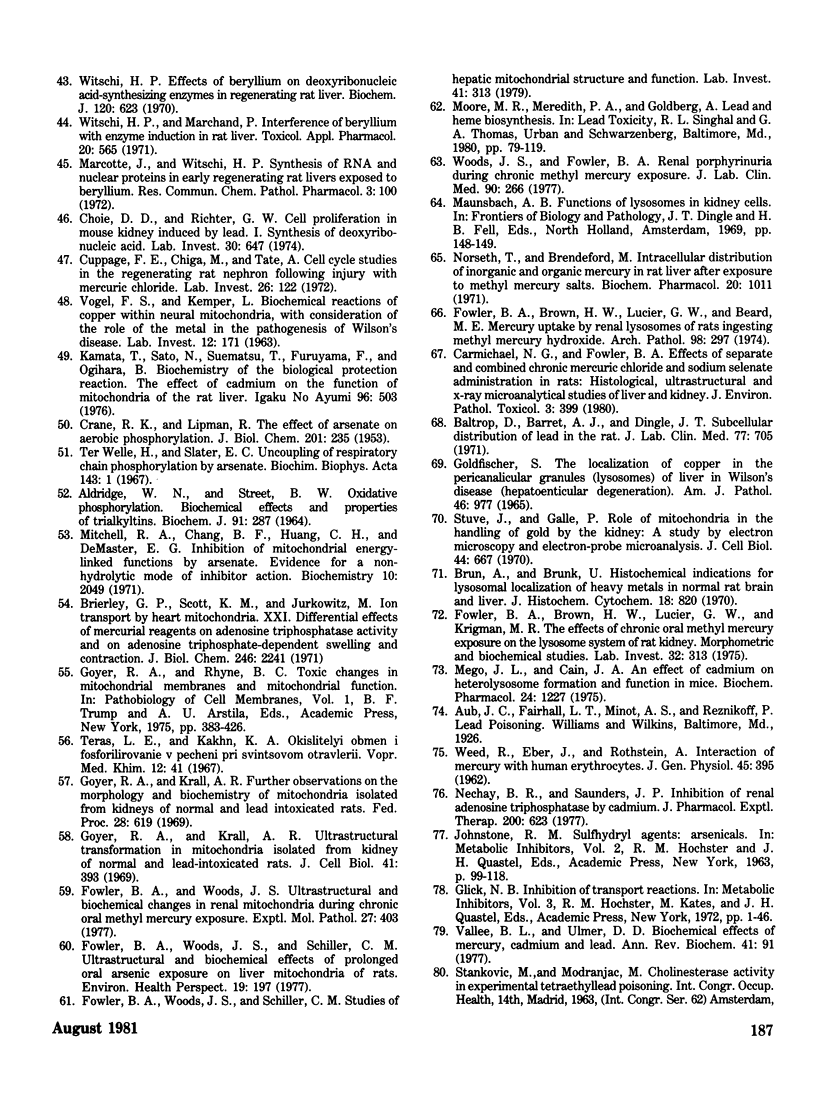
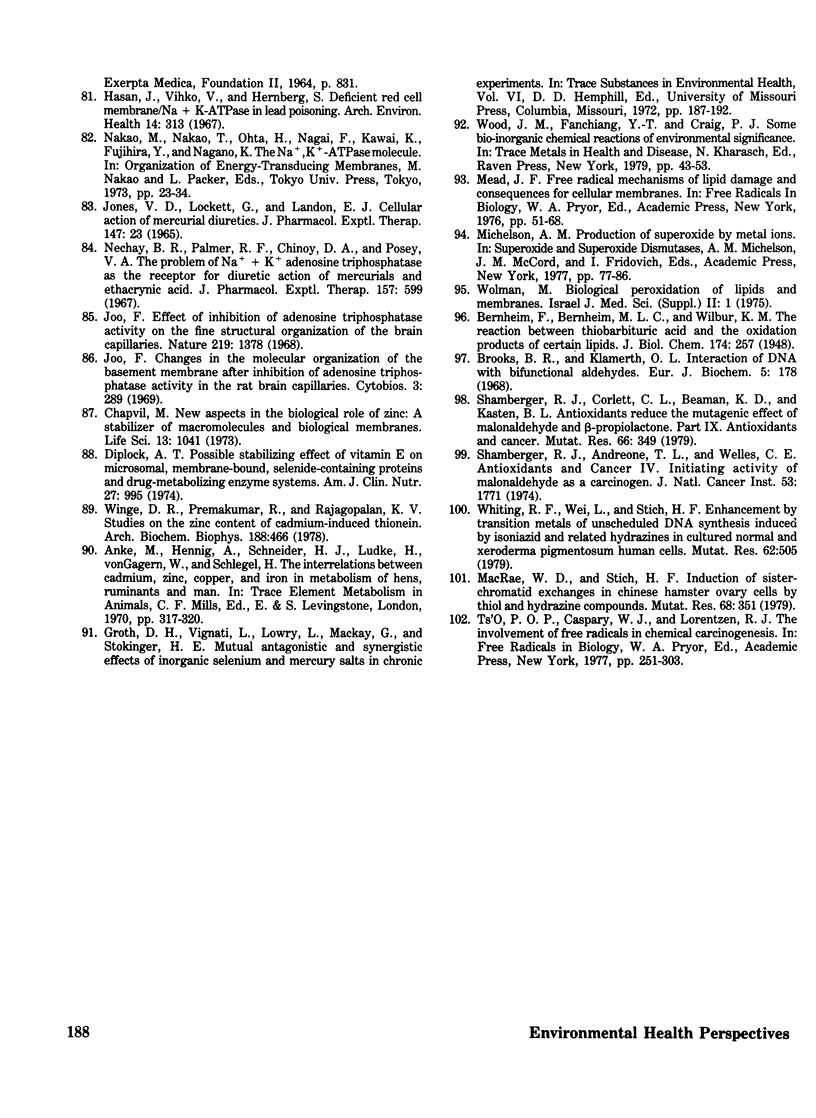
Selected References
These references are in PubMed. This may not be the complete list of references from this article.
- Aldridge W. N., Street B. W. Oxidative phosphorylation. Biochemical effects and properties of trialkyltins. Biochem J. 1964 May;91(2):287–297. doi: 10.1042/bj0910287. [DOI] [PMC free article] [PubMed] [Google Scholar]
- Alvares A. P., Kapelner S., Sassa S., Kappas A. Drug metabolism in normal children, lead-poisoned children, and normal adults. Clin Pharmacol Ther. 1975 Feb;17(2):179–183. doi: 10.1002/cpt1975172179. [DOI] [PubMed] [Google Scholar]
- Alvares A. P., Leigh S., Cohn J., Kappas A. Lead and methyl mercury: effects of acute exposure on cytochrome P-450 and the mixed function oxidase system in the liver. J Exp Med. 1972 Jun 1;135(6):1406–1409. doi: 10.1084/jem.135.6.1406. [DOI] [PMC free article] [PubMed] [Google Scholar]
- Anderson K. E., Fischbein A., Kestenbaum D., Sassa S., Alvares A. P., Kappas A. Plumbism from airborne lead in a firing range. An unusual exposure to a toxic heavy metal. Am J Med. 1977 Aug;63(2):306–312. doi: 10.1016/0002-9343(77)90246-7. [DOI] [PubMed] [Google Scholar]
- Barltrop D., Barrett A. J., Dingle J. T. Subcellular distribution of lead in the rat. J Lab Clin Med. 1971 May;77(5):705–712. [PubMed] [Google Scholar]
- Beach D. J., Sunderman F., Jr Nickel carbonyl inhibition of RNA synthesis by a chromatin-RNA polymerase complex from hepatic nuclei. Cancer Res. 1970 Jan;30(1):48–50. [PubMed] [Google Scholar]
- Brierley G. P., Scott K. M., Jurkowitz M. Ion transport by heart mitochondria. XXI. Differential effects of mercurial reagents on adenosine triphosphatase activity and on adenosine triphosphate-dependent swelling and contraction. J Biol Chem. 1971 Apr 10;246(7):2241–2251. [PubMed] [Google Scholar]
- Brooks B. R., Klamerth O. L. Interaction of DNA with bifunctional aldehydes. Eur J Biochem. 1968 Jul;5(2):178–182. doi: 10.1111/j.1432-1033.1968.tb00355.x. [DOI] [PubMed] [Google Scholar]
- Brubaker P. E., Klein R., Herman S. P., Lucier G. W., Alexander L. T., Long M. D. DNA, RNA, and protein synthesis in brain, liver, and kidneys of asymptomatic methylmercury treated rats. Exp Mol Pathol. 1973 Jun;18(3):263–280. doi: 10.1016/0014-4800(73)90024-5. [DOI] [PubMed] [Google Scholar]
- Brun A., Brunk U. Histochemical indications for lysosomal localization of heavy metals in normal rat brain and liver. J Histochem Cytochem. 1970 Nov;18(11):820–827. doi: 10.1177/18.11.820. [DOI] [PubMed] [Google Scholar]
- CRANE R. K., LIPMANN F. The effect of arsenate on aerobic phosphorylation. J Biol Chem. 1953 Mar;201(1):235–243. [PubMed] [Google Scholar]
- Carmichael N. G., Fowler B. A. Effects of separate and combined chronic mercuric chloride and sodium selenate administration in rats: histological, ultrastructural, and x-ray microanalytical studies of liver and kidney. J Environ Pathol Toxicol. 1979 Dec;3(1-2):399–412. [PubMed] [Google Scholar]
- Choie D. D., Richter G. W. Cell proliferation in mouse kidney induced by lead. I. Synthesis of deoxyribonucleic acid. Lab Invest. 1974 May;30(5):647–651. [PubMed] [Google Scholar]
- Choie D. D., Richter G. W. Dell proliferation in mouse kidney induced by lead. II. Synthesis of ribonucleic acid and protein. Lab Invest. 1974 May;30(5):652–656. [PubMed] [Google Scholar]
- Chvapil M. New aspects in the biological role of zinc: a stabilizer of macromolecules and biological membranes. Life Sci. 1973 Oct 16;13(8):1041–1049. doi: 10.1016/0024-3205(73)90372-x. [DOI] [PubMed] [Google Scholar]
- Conney A. H. Pharmacological implications of microsomal enzyme induction. Pharmacol Rev. 1967 Sep;19(3):317–366. [PubMed] [Google Scholar]
- Cuppage F. E., Chiga M., Tate A. Cell cycle studies in the regenerating rat nephron following injury with mercuric chloride. Lab Invest. 1972 Jan;26(1):122–126. [PubMed] [Google Scholar]
- Diplock A. T. Possible stabilizing effect of vitamin E on microsomal, membrane-bound, selenide-containing proteins and drug-metabolizing enzyme systems. Am J Clin Nutr. 1974 Sep;27(9):995–1004. doi: 10.1093/ajcn/27.8.995. [DOI] [PubMed] [Google Scholar]
- Eiseman J. L., Alvares A. P. Alterations induced in heme pathway enzymes and monooxygenases by gold. Mol Pharmacol. 1978 Nov;14(6):1176–1188. [PubMed] [Google Scholar]
- Fischbein A., Alvares A. P., Anderson K. E., Sassa S., Kappas A. Lead intoxication among demolition workers: the effect of lead on the hepatic cytochrome P-450 system in humans. J Toxicol Environ Health. 1977 Oct;3(3):431–437. doi: 10.1080/15287397709529576. [DOI] [PubMed] [Google Scholar]
- Fowler B. A., Brown H. W., Lucier G. W., Beard M. E. Mercury uptake by renal lysosomes of rats ingesting methyl mercury hydroxide. Ultrastructural observations and energy dispersive x-ray analysis. Arch Pathol. 1974 Nov;98(5):297–301. [PubMed] [Google Scholar]
- Fowler B. A., Brown H. W., Lucier G. W., Krigman M. R. The effects of chronic oral methyl mercury exposure on the lysosome system of rat kidney. Morphometric and biochemical studies. Lab Invest. 1975 Mar;32(3):313–322. [PubMed] [Google Scholar]
- Fowler B. A., Woods J. S., Schiller C. M. Studies of hepatic mitochondrial structure and function: morphometric and biochemical evaluation of in vivo perturbation by arsenate. Lab Invest. 1979 Oct;41(4):313–320. [PubMed] [Google Scholar]
- Fowler B. A., Woods J. S., Schiller C. M. Ultrastructural and biochemical effects of prolonged oral arsenic exposure on liver mitochondria of rats. Environ Health Perspect. 1977 Aug;19:197–204. doi: 10.1289/ehp.7719197. [DOI] [PMC free article] [PubMed] [Google Scholar]
- Fowler B. A., Woods J. S. Ultrastructural and biochemical changes in renal mitochondria during chronic oral methyl mercury exposure: the relationship to renal function. Exp Mol Pathol. 1977 Dec;27(3):403–412. doi: 10.1016/0014-4800(77)90010-7. [DOI] [PubMed] [Google Scholar]
- GOLDFISCHER S. THE LOCALIZATION OF COPPER IN THE PERICANALICULAR GRANULES (LYSOSOMES) OF LIVER IN WILSON'S DISEASE (HEPATOLENTICULAR DEGENERATION) . Am J Pathol. 1965 Jun;46:977–983. [PMC free article] [PubMed] [Google Scholar]
- Gelboin H. V. A microsome-dependent binding of benzo[a]pyrene to DNA. Cancer Res. 1969 Jun;29(6):1272–1276. [PubMed] [Google Scholar]
- Gelboin H. V., Kinoshita N., Wiebel F. J. Microsomal hydroxylases: induction and role in polycyclic hydrocarbon carcinogenesis and toxicity. Fed Proc. 1972 Jul-Aug;31(4):1298–1309. [PubMed] [Google Scholar]
- Goyer R. A., Krall R. Ultrastructural transformation in mitochondria isolated from kidneys of normal and lead-intoxicated rats. J Cell Biol. 1969 May;41(2):393–400. doi: 10.1083/jcb.41.2.393. [DOI] [PMC free article] [PubMed] [Google Scholar]
- Hasan J., Vihko V., Hernberg S. Deficient red cell membrane /Na++K+/-ATPase in lead poisoning. Arch Environ Health. 1967 Feb;14(2):313–318. doi: 10.1080/00039896.1967.10664738. [DOI] [PubMed] [Google Scholar]
- Hidalgo H. A., Koppa V., Bryan S. E. Effect of cadmium on RNA-polymerase and protein sythesis in rat liver. FEBS Lett. 1976 Apr 15;64(1):159–162. doi: 10.1016/0014-5793(76)80273-6. [DOI] [PubMed] [Google Scholar]
- JONES V. D., LOCKETT G., LANDON E. J. A CELLULAR ACTION OF MERCURIAL DIURETICS. J Pharmacol Exp Ther. 1965 Jan;147:23–31. [PubMed] [Google Scholar]
- Joó F. Effect of inhibition of adenosine triphosphatase activity on the fine structural organization of the brain capillaries. Nature. 1968 Sep 28;219(5161):1378–1379. doi: 10.1038/2191378a0. [DOI] [PubMed] [Google Scholar]
- Krasny H. C., Holbrook D. J., Jr Effects of cadmium on microsomal hemoproteins and heme oxygenase in rat liver. Mol Pharmacol. 1977 Jul;13(4):759–765. [PubMed] [Google Scholar]
- Lucier G., McDaniel O., Brubaker P., Klein R. Effect of methylmercury hydroxide on rat liver microsomal enzymes. Chem Biol Interact. 1972 Mar;4(4):265–280. doi: 10.1016/0009-2797(72)90021-x. [DOI] [PubMed] [Google Scholar]
- MacRae W. D., Stich H. F. Induction of sister-chromatid exchanges in Chinese hamster ovary cells by thiol and hydrazine compoudns. Mutat Res. 1979 Dec;68(4):351–365. doi: 10.1016/0165-1218(79)90167-8. [DOI] [PubMed] [Google Scholar]
- Maines M. D., Kappas A. Metals as regulators of heme metabolism. Science. 1977 Dec 23;198(4323):1215–1221. doi: 10.1126/science.337492. [DOI] [PubMed] [Google Scholar]
- Maines M. D., Kappas A. Regulation of heme pathway enzymes and cellular glutathione content by metals that do not chelate with tetrapyrroles: blockade of metal effects by thiols. Proc Natl Acad Sci U S A. 1977 May;74(5):1875–1878. doi: 10.1073/pnas.74.5.1875. [DOI] [PMC free article] [PubMed] [Google Scholar]
- Maines M. D., Kappas A. Studies on the mechanism of induction of haem oxygenase by cobalt and other metal ions. Biochem J. 1976 Jan 15;154(1):125–131. doi: 10.1042/bj1540125. [DOI] [PMC free article] [PubMed] [Google Scholar]
- Mego J. L., Cain J. A. An effect of cadmium and heterolysosome formation and function in mice. Biochem Pharmacol. 1975 Jun 15;24(11-12):1227–1232. doi: 10.1016/0006-2952(75)90067-2. [DOI] [PubMed] [Google Scholar]
- Miller J. A., Miller E. C. Chemical carcinogenesis: mechanisms and approaches to its control. J Natl Cancer Inst. 1971 Sep;47(3):V–XIV. [PubMed] [Google Scholar]
- Mitchell R. A., Chang B. F., Huang C. H., DeMaster E. G. Inhibition of mitochondrial energy-linked functions by arsenate. Evidence for a nonhydrolytic mode of inhibitor action. Biochemistry. 1971 May 25;10(11):2049–2054. doi: 10.1021/bi00787a013. [DOI] [PubMed] [Google Scholar]
- Moffitt A. E., Jr, Murphy S. D. Effect of excess and deficient copper intake on rat liver microsomal enzyme activity. Biochem Pharmacol. 1973 Jun 15;22(12):1463–1476. doi: 10.1016/0006-2952(73)90324-9. [DOI] [PubMed] [Google Scholar]
- Nechay B. R., Palmer R. F., Chinoy D. A., Posey V. A. The problem of Na+ + K+ adenosine triphosphatase as the receptor for diuretic action of mercurials and ethacrynic acid. J Pharmacol Exp Ther. 1967 Sep;157(3):599–617. [PubMed] [Google Scholar]
- Nechay B. R., Sauners J. P. Inhibition of renal adenosine triphosphatase by cadmium. J Pharmacol Exp Ther. 1977 Mar;200(3):623–629. [PubMed] [Google Scholar]
- Nordberg G. F., Andersen O. Metal interactions in carcinogenesis: enhancement, inhibition. Environ Health Perspect. 1981 Aug;40:65–81. doi: 10.1289/ehp.814065. [DOI] [PMC free article] [PubMed] [Google Scholar]
- Norton K. B., Kench J. E. Effects of cadmium on ribosomal protein synthesis in rat liver. Environ Res. 1977 Feb;13(1):102–110. doi: 10.1016/0013-9351(77)90008-1. [DOI] [PubMed] [Google Scholar]
- Rossman T. G. Effect of metals on mutagenesis and DNA repair. Environ Health Perspect. 1981 Aug;40:189–195. doi: 10.1289/ehp.8140189. [DOI] [PMC free article] [PubMed] [Google Scholar]
- Schnell R. C., Means J. R., Roberts S. A., Pence D. H. Studies on cadmium-induced inhibition of hepatic microsomal drug biotransformation in the rat. Environ Health Perspect. 1979 Feb;28:273–279. doi: 10.1289/ehp.7928273. [DOI] [PMC free article] [PubMed] [Google Scholar]
- Shamberger R. J., Andreone T. L., Willis C. E. Antioxidants and cancer. IV. Initiating activity of malonaldehyde as a carcinogen. J Natl Cancer Inst. 1974 Dec;53(6):1771–1773. [PubMed] [Google Scholar]
- Shamberger R. J., Corlett C. L., Beaman K. D., Kasten B. L. Antioxidants reduce the mutagenic effect of malonaldehyde and beta-propiolactone. Part IX. Antioxidants and cancer. Mutat Res. 1979 Apr;66(4):349–355. doi: 10.1016/0165-1218(79)90045-4. [DOI] [PubMed] [Google Scholar]
- Stoll R. E., White J. F., Miya T. S., Bousquet W. F. Effects of cadmium on nucleic acid and protein synthesis in rat liver. Toxicol Appl Pharmacol. 1976 Jul;37(1):61–74. doi: 10.1016/s0041-008x(76)80008-7. [DOI] [PubMed] [Google Scholar]
- Stuve J., Galle P. Role of mitochondria in the handling of gold by the kidney. A study by electron microscopy and electron probe microanalysis. J Cell Biol. 1970 Mar;44(3):667–676. doi: 10.1083/jcb.44.3.667. [DOI] [PMC free article] [PubMed] [Google Scholar]
- Sunderman F. W., Jr, Esfahani M. Nickel carbonyl inhibition of RNA polymerase activity in hepatic nuclei. Cancer Res. 1968 Dec;28(12):2565–2567. [PubMed] [Google Scholar]
- Sunderman F. W., Jr Inhibition of induction of benzpyrene hydroxylase by nickel carbonyl. Cancer Res. 1967 May;27(5):950–955. [PubMed] [Google Scholar]
- Sunderman F. W., Jr, Leibman K. C. Nickel carbonyl inhibition of induction of aminopyrine demethylase activity in liver and lung. Cancer Res. 1970 Jun;30(6):1645–1650. [PubMed] [Google Scholar]
- Sunderman F. W., Jr Nickel carbonyl inhibition of cortisone induction of hepatic tryptophan pyrrolase. Cancer Res. 1967 Sep;27(9):1595–1599. [PubMed] [Google Scholar]
- Sunderman F. W., Jr Nickel carbonyl inhibition of phenobarbital induction of hepatic cytochrome P-450. Cancer Res. 1968 Mar;28(3):465–470. [PubMed] [Google Scholar]
- VOGEL F. S., KEMPER L. Biochemical reactions of copper within neural mitochondria, with consideration of the role of the metal in the pathogenesis of Wilson's disease. Lab Invest. 1963 Feb;12:171–179. [PubMed] [Google Scholar]
- Vainio H., Sorsa M. Chromosome aberrations and their relevance to metal carcinogenesis. Environ Health Perspect. 1981 Aug;40:173–180. doi: 10.1289/ehp.8140173. [DOI] [PMC free article] [PubMed] [Google Scholar]
- Vallee B. L., Ulmer D. D. Biochemical effects of mercury, cadmium, and lead. Annu Rev Biochem. 1972;41(10):91–128. doi: 10.1146/annurev.bi.41.070172.000515. [DOI] [PubMed] [Google Scholar]
- WEED R., EBER J., ROTHSTEIN A. Interaction of mercury with human erythrocytes. J Gen Physiol. 1962 Jan;45:395–410. doi: 10.1085/jgp.45.3.395. [DOI] [PMC free article] [PubMed] [Google Scholar]
- Wagstaff D. J. Enhancement of hepatic detoxification enzyme activity by dietary mercuric acetate. Bull Environ Contam Toxicol. 1973 Jan;9(1):10–14. doi: 10.1007/BF01856764. [DOI] [PubMed] [Google Scholar]
- Whiting R. F., Wei L., Stich H. G. Enhancement by transition metals of unscheduled DNA synthesis induced by isoniazid and related hydrazines in cultured normal and xeroderma pigmentosum human cells. Mutat Res. 1979 Oct;62(3):505–515. doi: 10.1016/0027-5107(79)90046-0. [DOI] [PubMed] [Google Scholar]
- Winge D. R., Premakumar R., Rajagopalan K. V. Studies on the zinc content of Cd-induced thionein. Arch Biochem Biophys. 1978 Jun;188(2):466–475. doi: 10.1016/s0003-9861(78)80031-9. [DOI] [PubMed] [Google Scholar]
- Witschi H. P. Effects of beryllium on deoxyribonucleic acid-synthesizing enzymes in regenerating rat liver. Biochem J. 1970 Dec;120(3):623–634. doi: 10.1042/bj1200623. [DOI] [PMC free article] [PubMed] [Google Scholar]
- Witschi H. P., Marchand P. Interference of Beryllium with enzyme induction in rat liver. Toxicol Appl Pharmacol. 1971 Dec;20(4):565–572. doi: 10.1016/0041-008x(71)90261-4. [DOI] [PubMed] [Google Scholar]
- Wolman M. Biological peroxidation of lipids and membranes. Isr J Med Sci. 1975;11(11):1–248. [PubMed] [Google Scholar]
- Woods J. S., Carver G. T. Action of cobalt chloride on the biosynthesis, degradation, and utilization of heme in fetal rat liver. Drug Metab Dispos. 1977 Sep-Oct;5(5):487–492. [PubMed] [Google Scholar]
- Woods J. S., Carver G. T., Fowler B. A. Altered regulation of hepatic heme metabolism by indium chloride. Toxicol Appl Pharmacol. 1979 Jul;49(3):455–461. doi: 10.1016/0041-008x(79)90446-0. [DOI] [PubMed] [Google Scholar]
- Woods J. S., Fowler B. A. Altered regulation of mammalian hepatic heme biosynthesis and urinary porphyrin excretion during prolonged exposure to sodium arsenate. Toxicol Appl Pharmacol. 1978 Feb;43(2):361–371. doi: 10.1016/0041-008x(78)90015-7. [DOI] [PubMed] [Google Scholar]
- Woods J. S., Fowler B. A. Effects of chronic arsenic exposure on hematopoietic function in adult mammalian liver. Environ Health Perspect. 1977 Aug;19:209–213. doi: 10.1289/ehp.7719209. [DOI] [PMC free article] [PubMed] [Google Scholar]
- Woods J. S., Fowler B. A. Renal porphyrinuria during chronic methyl mercury exposure. J Lab Clin Med. 1977 Aug;90(2):266–272. [PubMed] [Google Scholar]
- Yamane Y., Sakai K., Uchiyama I., Tabata M., Taga N. Effect of basic cupric acetate on the biochemical changes in the liver of the rat fed carcinogenic aminoazo dye. I. Changes in the activities of DAB metabolism by liver homogenate. Chem Pharm Bull (Tokyo) 1969 Dec;17(12):2488–2493. doi: 10.1248/cpb.17.2488. [DOI] [PubMed] [Google Scholar]


